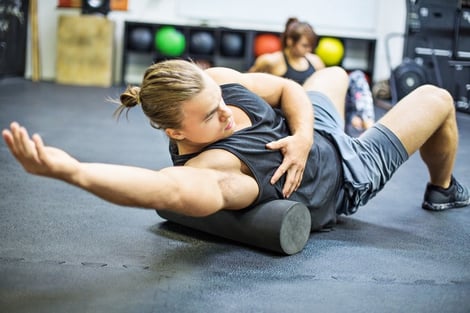 For the majority of my athletic and fitness career, getting sore from activities, workouts, practices, or games has not only been a sign that work has been done, but also a rite of passage. The saying, “no pain, no gain” came about as a result, and the world would judge successful workouts on soreness.
For the majority of my athletic and fitness career, getting sore from activities, workouts, practices, or games has not only been a sign that work has been done, but also a rite of passage. The saying, “no pain, no gain” came about as a result, and the world would judge successful workouts on soreness.
Those days have come and gone, and fitness professionals have come to the understanding that the old saying definitely needs updating. While getting a great workout and being sore is fine, being able to prevent injury, decrease soreness, improve mobility, and increase blood circulation are things we would like to incorporate into our wellness on a daily basis. One thing that I have found in my fitness journey is that you can get a great workout today, and with proper foam rolling (also known as self-myofascial release), you can get back after it tomorrow.
A Brief History of Foam Rolling
Foam rolling might seem like it’s a fairly new concept, but the idea has been around quite a while within manual physical therapy circles and with nontraditional medicine practitioners. In the late 19th century, physicians were using manual therapy to improve blood circulation and lymph flow. Although there are almost no studies that show that foam rolling had any benefits, the people that these techniques were being implemented on seemed to see the benefit.
Fast-forwarding to modern times, we have seen a boom in various industries associated with massage and related therapies. Individuals are seeing great results from meeting with these professionals and become interested not only in the tools they are using, but also in figuring out ways to implement similar techniques and experiences as a way to a quick-fix home remedy. Thus was born the foam roller, which now comes in many sizes, lengths, and shapes, and can be supplemented with everything from heat and ice to vibration discs.
How to Start Foam Rolling
Here are some quick tips and ideas to get you on your way.
- Choosing a density: Pick a foam roller density that matches your comfort level. The softer foam rollers are geared more for beginners who might be sensitive and unable to cope with the discomfort a denser foam roller brings. As you become more accustomed to foam rolling, you may increase the foam roller density to your desired comfort level. As with getting a deep-tissue massage, it might feel uncomfortable at the time, but you may feel great right away, and tomorrow you will feel like a million dollars!
- Rolling before and after bed: NIFS Personal Trainer Kris Simpson, a huge proponent and practitioner of foam rolling, says, “Foam rolling before bed is a great way to relieve muscle tension and stress from a long day. You will sleep better while being better rested, in turn giving you a head start on the following day. Again foam rolling in the morning would help get the blood flowing after a long, unrestful sleep.”
- Finding a pattern: Another NIFS Trainer, Cara Hartman, uses foam rollers with her athletes. She has all of her clients and athletes follow a pattern that makes sense. “We like to start lower posterior (calves) and work our way up (hamstrings, glutes, back, etc). Smaller muscles can be rolled with a little creativity. If you find yourself unable to perform a movement, try putting the foam roller against the wall and rolling vertically as opposed to horizontally.”
- Watch our video on how to properly foam roll.
As you work to get better at foam rolling, understand that it is very similar to everything you do in life. It will be most difficult the very first time you do it, but it will get a little easier each time you try it. I have a personal philosophy regarding foam rolling:
“If you want to maintain current mobility and flexibility, foam roll one time per day. If you want to increase mobility and flexibility, foam roll more than one time per day (the only limit is how much time you have to devote to your wellness). And if you want to get worse, do nothing!”
Foam Rolling at NIFS
NIFS has multiple foam-rolling stations designated to give you as many opportunities to roll as you need. There are multiple lengths and densities as well as a specialty roller made by Rollga. If you would like a quick tutorial and to talk about foam rolling with staff, please stop by the track desk and see one of the Health Fitness Specialists on staff. Get on a roller today, feel great tomorrow!
Evolve and rejoice
This blog was written by Thomas Livengood, devoted NIFS Health Fitness Trainer and Manager and avid blog writer. Missed by his NIFS family and members.

